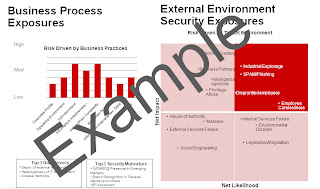I had the traditional form of documented security architecture consisting of security processes, diagrams with firewall placement, roadmaps, hype charts, etc. What I needed was something that someone could consume in one sitting and take away the priority and impact of a proposed strategic approach to security architecture. I looked at several methodologies (TOGAF, SABSA, etc.) and they were shaping up to be months of effort. These methodologies have their place and I'm not saying that the outcome wouldn't be worth the effort but in a time when we are asked to do more with less - I simply did not have the time to invest. If you do choose to adopt a methodology like SABSA, this approach can be built upon to reach the same outcome. Figure 1 below illustrates the process.
Figure 1: Rapid Security Architecture Development
The process described: Back to basics
1) Brainstorm Security Services - I built a database of all the security services that any security organization could offer. I brainstormed and documented over 65 core services ranging from Authentication to Vulnerability Assessments. The Security Services database should continue to grow as the security program changes to meet new challenges.
2) Align Services with Technology - I chose to include this step to show alignment with our Enterprise Architecture team and to show services that were enhanced or covered by technology today.
3) Align Services with Defensive Strategies - Group the services into groups called Defensive Strategies. The defensive strategies should also align with the business and IT strategy if you ever expect to get any projects accomplished.
4) Organization assessment against listed security services - Assess each security service to determine what the status is. Assign YES for security service is working; Assign PARTIAL for partial coverage and; Assign NO for not offered.
5) Align threats and gaps with the corporate enterprise risks - This is a multi-step process:
a) Develop a threat taxonomy - brainstorm all the threats that could have an impact on your particular business. You can choose general threats like Abuse of Authority, Disgruntled Employees and Environmental Disaster. Group the threats by Internal Malicious, External Malicious, Internal Non-malicious and External Non-malicious (this helps one understand threat vectors).
b) It is a good idea to show risky business practice ratings, risk drivers/security motivators and show the Net Impact and Net Likelihood of the threats (Fig 2). This gets the attention of leaders who understand threats and risks in business terms and places a kind of dashboard all on one slide.
Figure 2: Security Risk Context Example
6. Document the impact or priority of the security services - assign a HIGH, MEDIUM and LOW impact to each service to indicate the security services that are important to your organization.
7. Document the gaps in current services - By just adding up the number of services with yes, no and partial then looking at the impact rating, it is easy to see where time money and effort should be spent.
7. Document the gaps in current services - By just adding up the number of services with yes, no and partial then looking at the impact rating, it is easy to see where time money and effort should be spent.
8. Align gaps with the corporate threat taxonomy - As you develop the threat taxonomy and align the threat with the risk this process helps you think of mitigation for the risks. Simply align the risk with a security service.
9. Report findings - The alignment of gaps from step 8 will show you the services that you need to address the risks. Figure 3 shows an example of how I might report the MFA security service, relevant threats and risk before and after the mitigation is applied and figure 4 shows another method of reporting the security services and before and after mitigation. The risk level can be determined using the National Vulnerability Database by going through the weighted questions for each risk then going through them again and applying the security service. This process may surprise you.
Figure 3: Example Security Service MFA
10. Create a business aligned security roadmap - The roadmap will be all the security services that are developed as a result of your work. Estimate external cost and time to implement for each security service as shown in Figure 3 in the lower right hand corner, this will help business leaders understand the level of effort and cost.
Whether you use this approach or another (or a combination) the result of an effort like this should benefit any security program. I hope this helps readers strengthen their program or will expand your thinking. If you find this useful, please just let me know - I like the endorphin rush when someone gains from my research, thought and hard work.




No comments:
Post a Comment